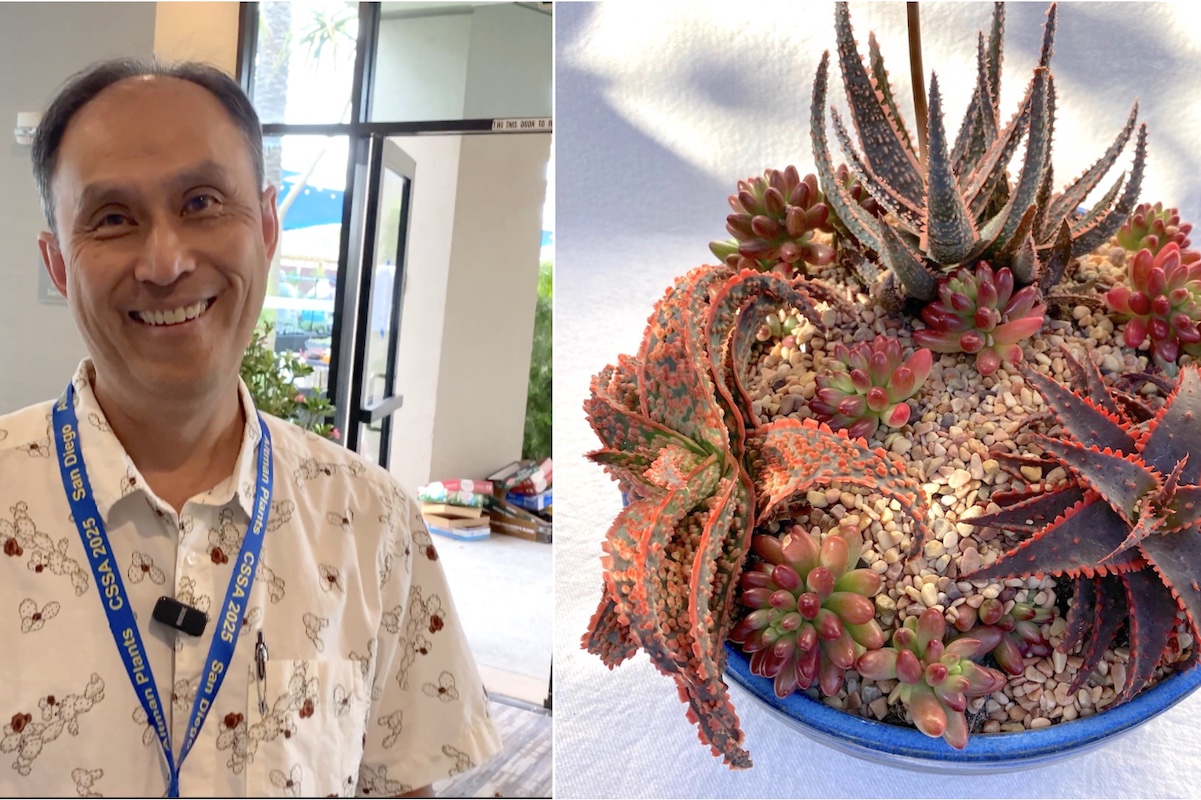
12 Collectible Succulents Anyone Can Grow
At the recent convention of the Cactus & Succulent Society of America (CSSA) in San Diego, it was fun to catch up with old friends and meet collectors, and vendors from all over. To break the ice, and because I was curious what they'd say, I asked a dozen experts:

My question for CSSA experts
Haworthias won by a narrow margin
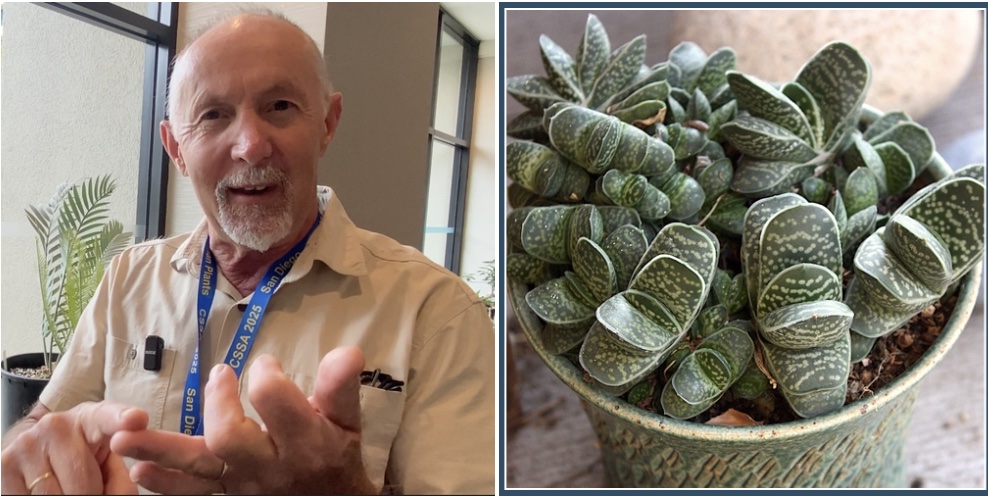
Attila Kapitany and Gasteria bicolor var. liliputana
Surprisingly, only two chose the same type of succulent. Convention speaker Attila Kapitany from Australia said, "There are so many choices, but if anything, it has to be safe, hardy, versatile, non-poisonous, and non-spiny. Haworthias!" His second choice was gasterias. "A little more demanding, but just as versatile. And both haworthias and gasterias can grow indoors."
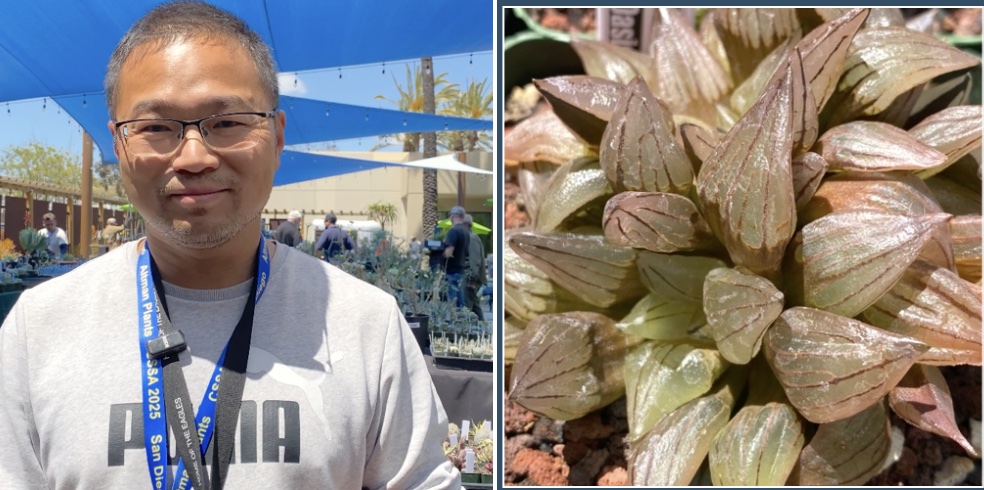
Jack Tian and Haworthia atrofusca 'Watermelon'
For beginners eager to collect unusual succulents but who "don't have much experience," Jack Tian of Thorn Oasis also recommends haworthias. They're widely grown, Jack said, adding that hybridizers in the US and beyond continually introduce new varieties with wonderful forms and patterns.
Euphorbias: one common, one unusual

Al Klein and Euphorbia obesa
Two expert growers, also vendors, recommended plants in the genus Euphorbia, but the species each chose couldn't be more different. Al Klein of Botanic Wonders went with bestselling Euphorbia obesa. He recommends growing "baseball plants" in a fast-draining mix---his is 80 percent pumice and 20 percent peat moss---in pots not much larger than the diameter of the plant. "Letting them get pot-bound is OK."
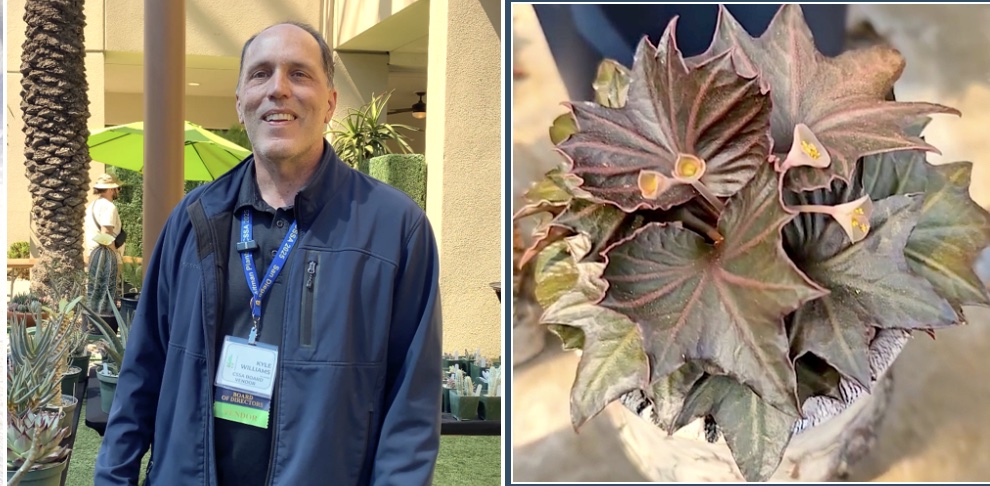
Kyle Williams and Euphorbia francoisii
The other Euphorbia enthusiast, Kyle Williams of Kyle's Plants, surprisingly recommended obscure Euphorbia francoisii ("fran-SWA-see-eye"). Kyle, who often goes to Thailand, brings back these leafy, seed-grown succulents that form a caudex over time. Collectible Euphorbia francoisii specimens are multicolored, often with prominent veining, and may have overlapping, star-shaped leaves. "They're amazing houseplants," Kyle said. "They need low to medium light, and warm, even temperatures." And typical of succulents, "They don't want to be soaking wet, but don't let them go dry."
For cactus lovers
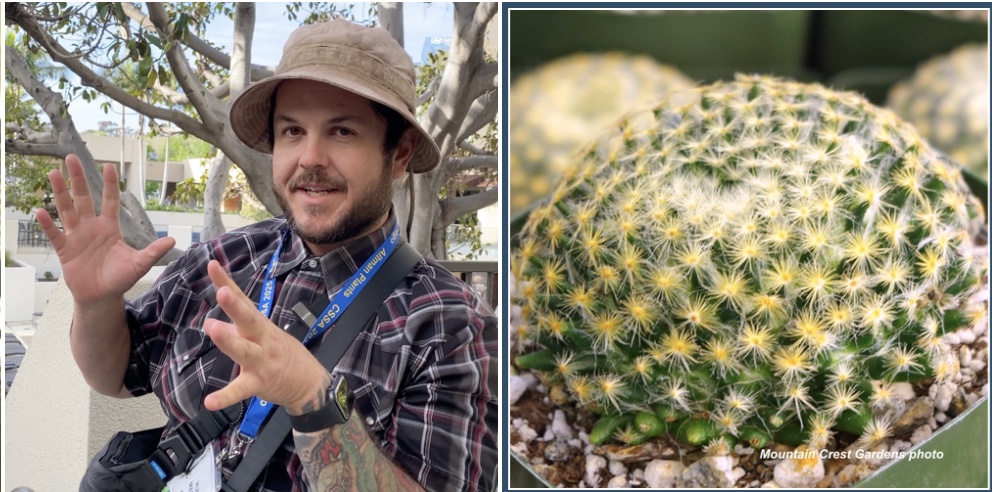
Hunter Martinez and Mammillaria shiedeana
Collector Hunter Martinez of Cactus Quest on YouTube chose the genus Mammillaria, because "their geometry and forms are really beautiful." For people who don't like spines, he suggests mams with fine, flexible, pectinate spines, which are "more like feathers covering the body than knives sticking out." One pectinate species Hunter is "infatuated" with after seeing it in habitat in Querétaro, Mexico is Mammillaria shiedeana.
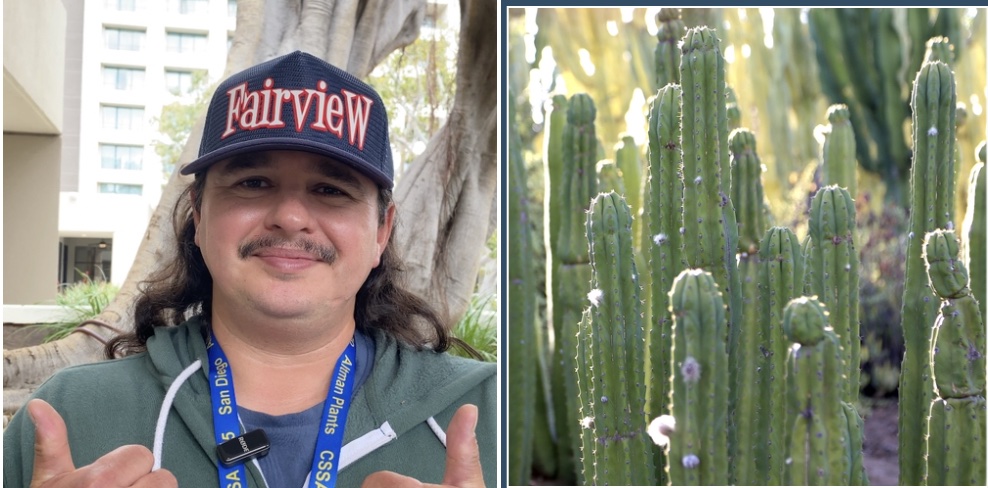
Ralph Moran with San Pedro cactus (Echinopsis pachanoi)
Ralph Moran is a horticulturalist on staff at the San Diego Zoo, where the plant collection exceeds that of the animals. He likes how easy succulents are to propagate and grow. One he said is "so common people give it away," makes a statement in any landscape and starts readily from cuttings: Echinopsis (Trichocereus) pachanoi (San Pedro cactus). "Chop, callus, plant," Ralph said with a smile. "Neglect them, water whenever, and they'll give you a nice, tall, columnar cactus."
Aloes tall and small

Phúc Huynh with a pot of sedum and dwarf Aloe hybrids
Phúc Huynh ("Fook Hwin") from Redlands, CA, serves on the CSSA Board of Directors. He recommends aloes as a genus that's rewarding, easy-care, and fast-growing. Phúc personally prefers tree aloes (now split into Aloidendron), but for beginners, he suggests such in-ground varieties as Aloe vera, Aloe cameronii, or others in nurseries and garden centers. For pots, Phúc recommends colorful, dwarf cultivars from Altman Plants. (Which are sold at Oasis nursery north of San Diego -- DLB.)
Online live-sale vendors
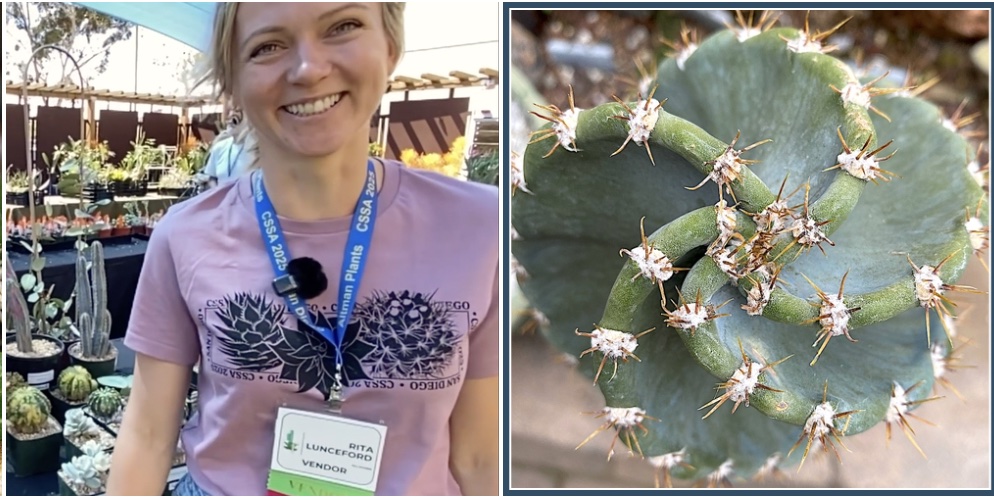
Rita Lunceford with spiral cactus (Cereus forbesii spiralis)
Rita Lunceford of Grow Margo and Poon Thongpool of Beleaf and Grow both have online shops specializing in succulents and exotics, and both do live sales. For beginning collectors, Rita recommends one of her bestsellers: spiral cactus (Cereus forbesii spiralis).

Poon Thongpool with Dracaena (Sansevieria) 'Moonshine'
Poon, originally from Thailand, imports plants from there, China, and Italy. She suggested sansevierias (now lumped with Dracaena), especially her favorite: silvery-green 'Moonshine'.
Btw, if you're looking for a particular succulent, Poon or Rita might be able to help. Both keep up with what's available from growers in San Diego and beyond.
For the climate-challenged
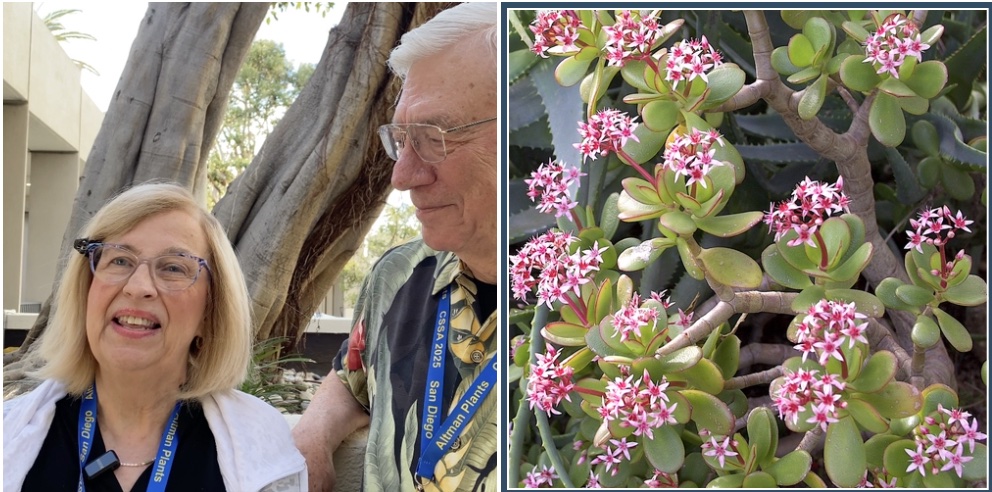
Cindy and Richard Schreiber with Crassula ovata
Richard Schreiber, president of the Mid-Iowa CSS in Des Moines, and his wife---club treasurer Cindy Schreiber---suggest that aspiring collectors who contend with harsh winters start with jade (Crassula ovata), of which there are many varieties. To get them to flower indoors, Cindy says, "Take them outside so they're happy all spring and summer, and when you bring them indoors in September, you'll notice they'll have little buds." She added that "shorter days and longer nights are what causes them to bloom."
Addictive caudiciforms
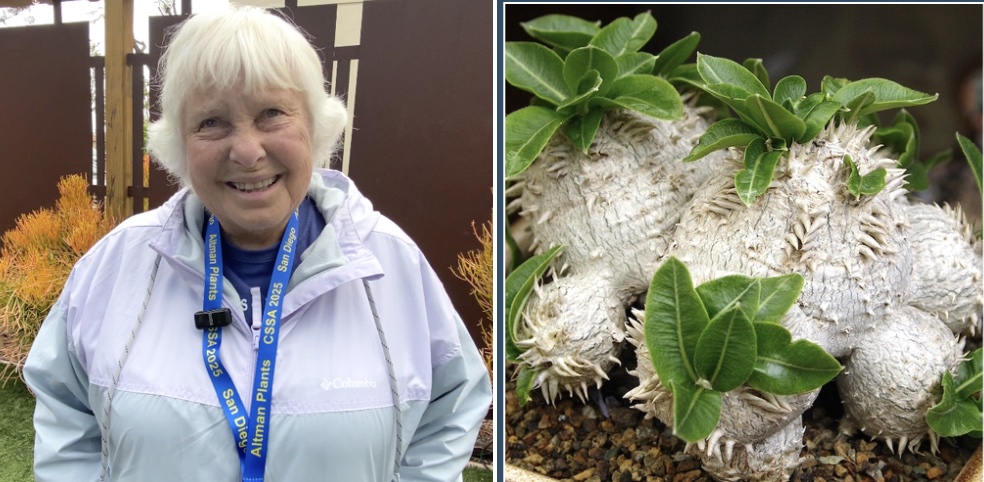
Tina Zucker with Pachypodium brevicaule
San Diego CSS member Tina Zucker has been collecting, propagating and selling succulents for nearly 50 years. What first excited her about succulents were caudiciforms: plants with a caudex---a thickened, fleshy, bulb-like base or trunk that stores water and nutrients. Many caudiciforms are succulents, despite having thin leaves. "They're addicting," Tina says. "There are so many kinds."
Agaves and More
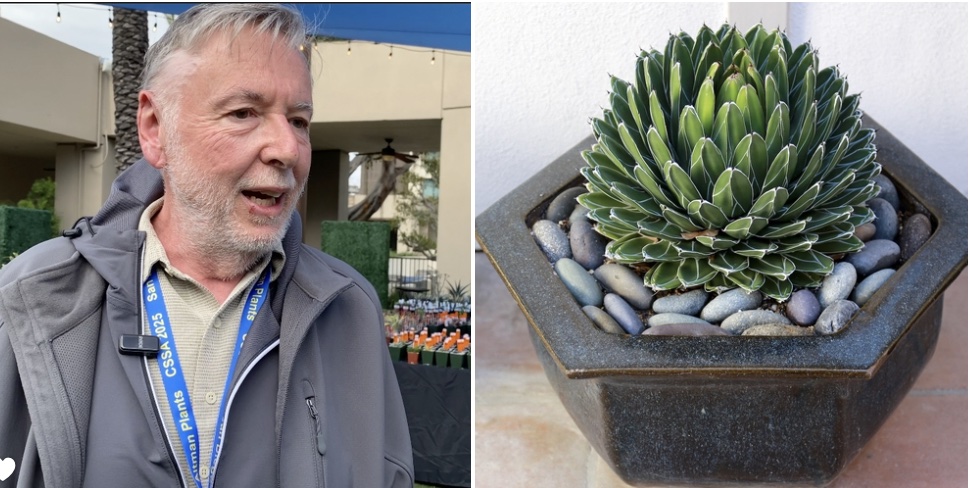
Gerhard Bock and Agave victoriae-reginae
Agaves are still his first love, says another plant addict: Gerhard Bock, who does the popular blog, "Succulents and More." "They're so variable," he explained. Gesturing to juvenile agaves in the sale area, including Agave albopilosa, he added, "you might think those were completely unrelated plants." Agaves that get large "make great landscape plants," Gerhard noted, "and small ones make great potted specimens." His favorite species? Agave victoriae-reginae. "It has beautiful markings, and can live in a pot for 30 years before flowering."
Do you agree with these top-flight succulent growers, vendors, authors, speakers and collectors? Let us know in the comments below, or on the video's YouTube page. Thanks for coming along! ~ Debra
Related Info on This Site
Types of Succulents from Aeonium to Zebra Plant, Photos & IDs
Debra’s Dozen Easy-Grow Succulent Plants for Beginners
Trying to make sense out of succulents? There are numerous varieties, but these are the most common succulents and those you’ll likely run across. Enjoy growing and discovering these fascinating “plants that drink responsibly!”

-custom_crop.jpg)
Agreed with all the experts, anyway I’m not a beginner because I’ve been collecting plants for almost three years now and learning about the basics care from most of the experts here on YouTube. Killed more succulents than cactus (one or two cactus) I’m not there yet but I’m hoping to keep all alive, including other plants 🌱. Love your channel on YouTube and this site. You are the best